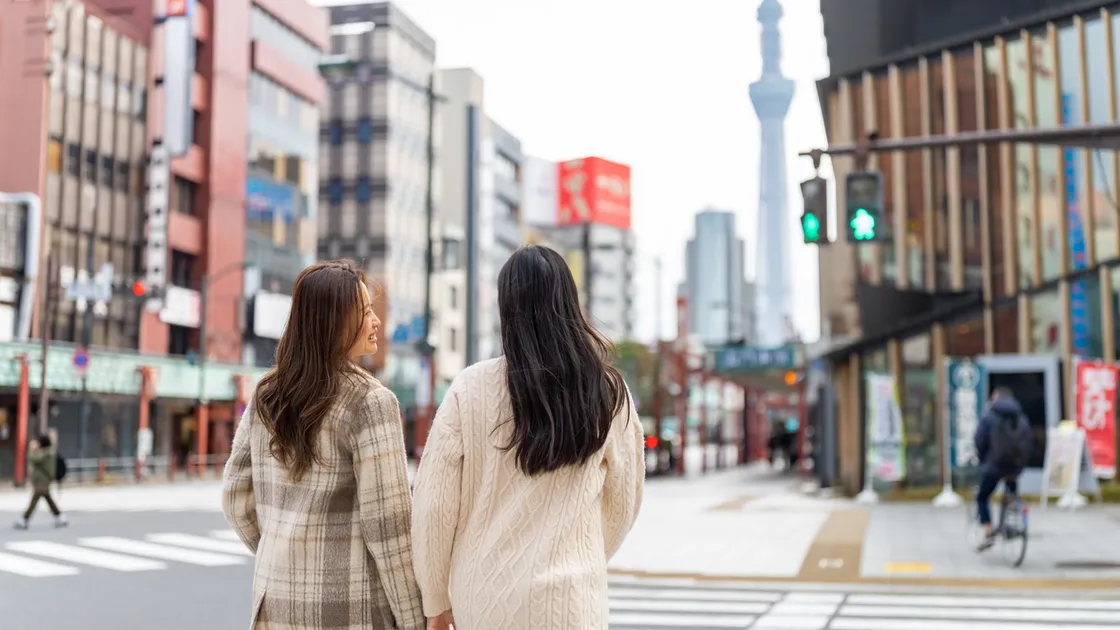Why Ambient Marketing Is Gaining Attention in Japan: Cultural Context and Keys to Success

In the Japanese market, many marketers feel that traditional advertising alone often gets lost in the noise, making it difficult to truly capture consumer attention. This is where ambient marketing—leveraging everyday spaces as part of the brand experience—comes into focus.
By surprising consumers and engaging them through memorable experiences, ambient marketing not only leaves a lasting impression but also sparks organic sharing on social media.
In this article, we will explore how to successfully implement ambient marketing in Japan, with practical insights into navigating the country’s unique cultural context and regulatory environment.
What Is Ambient Marketing? Why It’s Gaining Attention in Japan
In today’s world of constant advertising exposure, many consumers are growing weary of traditional “push-style” ads. Against this backdrop, ambient marketing—which blends seamlessly into everyday spaces and leaves lasting impressions through surprise and experience—is attracting renewed attention.
In Japan, this approach is particularly relevant due to cultural values that emphasize empathy and trust, as well as broader consumer trends such as the rise of experiential consumption. This section explores the definition of ambient marketing, why it resonates in Japan, and what role it plays as part of a broader marketing strategy.
Defining Ambient Marketing and Its Key Features
Ambient marketing is a strategy that integrates advertising into the everyday environments where people live and move, creating unexpected encounters. It leverages spaces like train stations, parks, cafés, and retail stores to deliver memorable brand experiences.
Unlike TV commercials or banner ads that simply “show” a message, ambient marketing places value on “letting people experience” the brand. Famous examples include staircases transformed into giant piano keys that play sounds as people walk, or household items designed to subtly carry brand stories.
These moments of surprise tend to leave strong impressions and often spark organic sharing on social media. As a result, brands can generate widespread buzz through word of mouth, without the need for massive advertising budgets.
In recent years, more campaigns are combining ambient approaches with digital technologies—such as AR or IoT—to create immersive, interactive experiences.
Alignment with Japanese Consumer Behavior
In Japan, consumers increasingly prioritize trustworthiness and seamlessness in advertising. While digital ad exposure is growing, many—especially younger audiences—express frustration with intrusive ads. As a result, value is shifting away from frequency of exposure toward quality of experience.
At the same time, Japanese consumers are placing greater value on experiences over material goods. Experiences are easily shared on social media, serving not only as personal memories but also as forms of self-expression. This makes ambient marketing—with its focus on surprise and playfulness—highly likely to resonate.
Japan’s OOH (out-of-home) and DOOH (digital out-of-home) markets are also expanding in urban areas, particularly as channels for reaching younger audiences. Advances in location-based data measurement are further enabling both spontaneous experiences and concrete performance evaluation.
Culturally, Japanese consumers also associate advertising with reassurance and social harmony, meaning campaigns that are tied to local communities or cultural contexts are especially well received.
Overall, Japanese consumers welcome “natural and enjoyable advertising experiences.” As ad fatigue spreads, the value of ambient marketing is rising sharply in Japan.
Successful Cases of Ambient Marketing in Japan
The value of ambient marketing—its ability to leave a lasting impression on consumers—becomes clearer when looking at real-world examples. In Japan, successful initiatives can be found across a wide range of contexts, from corporate promotions in industries like beverages and fashion to projects staged in public spaces and municipalities.
This section introduces case studies by industry and explains how these campaigns created meaningful consumer touchpoints. For overseas brands, these examples also serve as practical references for cultural adaptation and creative direction when entering the Japanese market.
Corporate Campaigns (Beverage & Fashion Industries)
In the beverage sector, campaigns that leverage unexpected encounters in everyday city life have proven highly effective.
source : https://edu.watch.impress.co.jp/docs/news/1616302.html
Coca-Cola also launched an engaging campaign in Shibuya by installing a “Lucky Bottle Vending Machine.” Each purchase felt like drawing a lottery, turning the act of buying a drink into a playful experience.
The campaign encouraged users to share their experience on social media with the hashtag #福ボトル (#LuckyBottle), transforming an ordinary purchase into a form of entertainment.
As a result, the initiative not only boosted sales but also strengthened brand favorability among consumers.
source : https://prtimes.jp/main/html/rd/p/000000306.000001735.html
Public Spaces and Municipal Initiatives
Ambient marketing that leverages public spaces can also deliver social value, such as revitalizing local communities and attracting tourism.
For example, JR East (East Japan Railway Company) launched the “JAPAN ART BRIDGE” project, transforming locations like the historic former Manseibashi Station into immersive contemporary art experiences.
By integrating railway assets with public spaces, the initiative created new touchpoints with both commuters and local residents, demonstrating how ambient marketing can serve not only commercial goals but also community engagement.
source : https://bijutsutecho.com/magazine/news/report/27192
In Osaka, initiatives such as “Dotonbori Art Street” and the Yodogawa Wall Mural Project have been transforming public spaces into open-air art experiences.
These efforts not only enhance the city’s symbolic identity and appeal as a tourist destination but also provide passersby with moments of unexpected discovery and delight.
source : https://arts-city-commons.jp/projectstudy/mural/2/
Benefits and Potential Risks of Ambient Marketing
Ambient marketing can deliver unique results that are difficult to achieve through other advertising methods. At the same time, it also carries certain risks and challenges. Below, we outline the key advantages and considerations to help guide decision-making when planning an ambient campaign in Japan.
Expected Benefits (Memorability & Social Sharing)
The biggest appeal of ambient marketing lies in its element of surprise and ability to stick in memory. When consumers encounter an unexpected brand experience in their daily lives, it tends to leave a stronger impression than traditional one-way advertising.
In today’s environment, consumers are eager to share unique experiences on social media. Street-level activations or interactive installations trigger a natural desire to “take photos” and “share”, fueling organic amplification. This allows brands to achieve widespread exposure without heavy ad spend.
In addition, the positive emotions created through these experiences often enhance brand favorability and consumer engagement. In Japan, where word-of-mouth culture is deeply rooted, recommendations from friends and family carry strong influence. A single experience can spread organically through social networks, sometimes generating returns far greater than the initial investment.
Challenges and Backlash Risks
However, there are important risks to consider. Overly elaborate setups or activations that disrupt consumer routines can cause irritation rather than delight. If an unexpected encounter is perceived as an inconvenience instead of a pleasant surprise, social media amplification may backfire and damage the brand image.
Japan also presents unique challenges, particularly regarding the use of public spaces. Campaigns staged in train stations, parks, or other shared environments require coordination with local authorities, and in some cases, permission may be denied. Strict regulations mean that comprehensive risk assessments are essential in the planning phase.
Cost is another factor. While ambient marketing can generate buzz quickly, the design and installation often require significant investment. It is not always a low-budget, universally applicable method. Moreover, if a campaign generates more attention than expected, companies may face secondary issues such as insufficient staffing, poor customer support, or product shortages.
In short, ambient marketing is a high-risk, high-reward strategy. The keys to success are balancing surprise with empathy, tailoring campaigns to cultural context, and embedding risk management into every stage of execution.
Practical Steps for Success in Japan
To succeed with ambient marketing in Japan, brands must approach each phase—planning, execution, and evaluation—with careful design and cultural localization. Below are actionable steps and key considerations for practitioners. For overseas brands entering Japan, understanding the country’s unique regulations and cultural sensibilities is not optional but essential. Success depends on creating campaigns that resonate authentically with local consumers, rather than simply replicating global models.
Planning & Target Analysis
The first step is to clearly define the brand’s objectives and KPIs—whether that is awareness, favorability, social media amplification, or purchase intent.
Next, analyze “place-based data” such as pedestrian traffic, dwell time, and movement patterns to identify the most effective locations. If using public spaces, coordination with local governments, railway operators, or station management companies is required, along with obtaining the necessary permits.
Supporting the plan with research and market data adds credibility. For instance, Japan’s OOH (out-of-home) advertising market showed slight growth in 2024, reaching 100.8% of the previous year, with urban areas in particular experiencing signs of recovery. This demonstrates the ongoing relevance of outdoor and transit advertising as part of a broader media mix.
source : https://dentsu-ho.com/articles/9205
Market forecasts for Japan’s OOH/DOOH (out-of-home and digital out-of-home) advertising sector project that it will reach a scale of USD 3.86 billion by 2025.
source : https://www.mordorintelligence.com/ja/industry-reports/japan-ooh-and-dooh-market
Japan ranks as the third-largest out-of-home (OOH) advertising market in the world, with a highly concentrated structure—four major railway advertising companies account for 78% of the transit ad market. Industry data also shows that DOOH (digital out-of-home) makes up 14.5% of the market, while programmatic OOH represents around 6%.
Understanding this market structure provides valuable context and depth when designing ambient marketing strategies.
source : https://dentsu-ho.com/articles/8646
In addition, brands should combine social media conversation analysis with consumer surveys to gain deeper local insights. By visualizing the interests and preferences of Gen Z and Millennial audiences, campaigns can be designed with far greater precision and relevance.
Execution, Installation, and Staging
Once the location is selected, the next step is installation and staging. The design must balance delivering surprise while avoiding discomfort or disruption.
After installation, conduct visibility checks and test runs to confirm dwell points and lines of sight. For DOOH (digital out-of-home) activations, ensuring viewability is critical—for example, positioning screens so they are not obstructed by objects.
Incorporating dynamic elements such as video, lighting, or sound, as well as variations by time of day, can capture more attention and engage passersby. At the same time, energy efficiency and sustainability are important considerations in Japan, so factors like LED performance and power consumption during extended operation must be addressed.
Campaigns also gain greater impact when connected to seasonal themes or local events, which foster a sense of familiarity and encourage natural participation from the community.
Measuring Effectiveness and Running Improvement Cycles
Every activation should be paired with a measurement framework. Useful KPIs include:
- Pedestrian counts (estimated impressions)
- Dwell rate (percentage of people who stopped)
- Social media amplification (number of posts, likes, hashtag usage)
- Changes in brand awareness or favorability
- Influence on purchase intent
For digital OOH, companies often use VAC (Visibility Adjusted Contact) studies to estimate impressions. Many Japanese DOOH networks base pricing and campaign evaluation on this metric, enabling more accurate performance assessment.
To drive continuous improvement, brands should adopt an iterative cycle: use initial data to refine intensity and placement of installations, then redeploy and retest (test → analyze → redesign → relaunch).
Collecting qualitative data—such as consumer interviews or social media comments—adds further value, capturing the emotional impact that raw numbers might miss and providing insights for future campaigns.
Amplification Strategy and Word-of-Mouth Design
One of the strengths of ambient marketing is that consumers naturally share their experiences on social media. To maximize this, it’s essential to intentionally design “shareable moments”—photo spots that encourage people to take and post pictures. These could include photogenic structures, details that convey the brand’s world, or installation-style features.
Supporting strategies such as hashtag campaigns and influencer engagement help create a seamless flow from experience → posting. Brands can further boost amplification by responding in real time through official accounts or by launching repost campaigns.
Adding incentives such as exclusive perks or coupons enhances shareability. Consumers gain a tangible reason to share, making the spread of content more organic and effective.
Localization and Cultural Adaptation
Simply importing a successful concept from abroad can risk cultural misalignment. Understanding Japanese cultural sensibilities—such as the appreciation of subtle beauty, modesty, and indirect expression—is essential for fine-tuning tone and presentation.
Japanese-language signage, instructions, and descriptions should be designed to be clear, simple, and respectful. For example, avoid overhyping the experience in advance; keep explanations and guidance minimal to prevent any sense of being “forced” upon the consumer.
When collaborating with municipalities or commercial facilities, integrating local history, events, traditions, and regulations into the execution helps build resonance with the community.
Additionally, segment-based localization can be highly effective. Messaging that resonates with younger audiences may not appeal to seniors, so tailoring expressions to different demographics is often a decisive factor for success.
Continuity and Budget Management
To avoid ambient marketing becoming just a one-off stunt, it is crucial to design for long-term continuity. Locations and executions that proved effective should be documented, templated, or modularized so they can be adapted and reused in future campaigns.
When budgeting, factor in all stages of the project—from initial design and construction to execution, maintenance, and measurement—and always include a contingency reserve. In public spaces, don’t overlook additional costs such as permits, insurance, and removal fees.
Collaborations with sponsoring companies or local governments can also help share costs. Building strong partnerships is the key to balancing sustainability and cost efficiency over the long term.
Key Considerations for Launching in Japan
Replicating ambient marketing tactics that worked abroad without adaptation can be risky in Japan. A lack of understanding of local cultural context and legal regulations may lead to backlash or even public controversy.
The Importance of Cultural Localization
Japanese consumers tend to dislike advertising that feels overly intrusive or pushy. Campaigns that are too flashy or self-assertive risk triggering resistance rather than engagement. Instead, approaches that emphasize subtle humor or relatable storytelling are far more effective.
It is also worth noting that while shock-based advertising may resonate in Western markets, in Japan it is often perceived as unpleasant or inappropriate. Marketers must carefully adjust tone and expression to align with Japanese sensitivities.
Understanding Regulations and Operational Rules
When executing campaigns in public spaces such as train stations or parks, obtaining official approval from local authorities and facility managers is essential. Brands must also ensure compliance with Outdoor Advertising Ordinances and landscape regulations. These restrictions are particularly strict in urban areas, where unauthorized installations or exaggerated expressions may result in immediate removal or penalties.
Partnering with Local Experts
To succeed in the Japanese market, collaborating with local advertising agencies, production companies, and other specialists is often the most effective path. Proper coordination through the right channels is critical. Trusted partners not only streamline approvals but also help navigate the cultural nuances and regulatory complexities that foreign brands may find challenging.
Conclusion and Next Steps
Ambient marketing has emerged as a powerful response to advertising fatigue, offering consumers moments of surprise, delight, and empathy. In Japan, this approach is especially promising: the market favors subtle, natural expressions of advertising and places high value on experiential engagement.
At the same time, Japan’s advertising landscape has its own unique structures and regulations, making partnership with local experts a critical factor for success.
If your brand is looking to strengthen its presence in Japan or explore innovative ways to connect with consumers, ambient marketing deserves serious consideration. Start small with test initiatives, learn from real-world feedback, and build expertise alongside trusted local partners.
And for brands seeking a structured approach to market entry, tapping into the broad marketing expertise of hotice can help unlock new opportunities and ensure campaigns resonate effectively within Japan.






